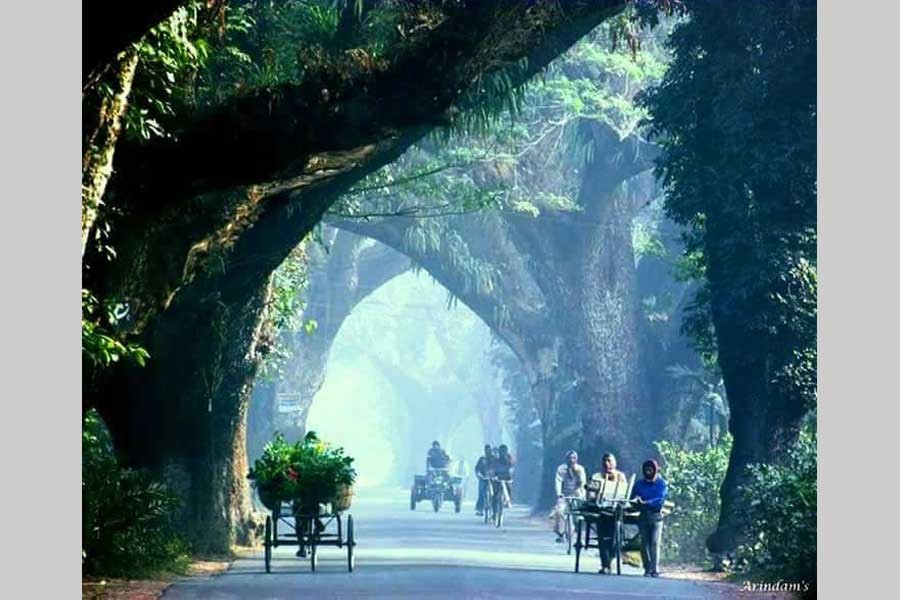The Jessore Road has been immortalised in the poem, September on Jessore Road by Allen Ginsberg. The American radical poet's heart-rending description of the conditions of the refugees fleeing from the genocidal atrocities of the Pakistan army in occupied Bangladesh in 1971 moved world conscience as well as rallied world support for the cause of Bangladesh liberation.
One of the features of this road that connects Kolkata with Jessore, is the century-old trees on its both sides. In the name of widening the road, governments in Bangladesh and India have undertaken a programme of felling the trees. This has created a furore among people in both Bangladesh and India. Both mainstream and social media are abuzz with protests against this move.
On Thursday, a High Court bench issued a status-quo on the felling of these century-old trees for six months. Following a writ petition filed by Human Rights and Peace for Bangladesh, the High Court also issued a rule asking the government to explain why the decision to chop down the trees should not be declared illegal.
These age-old trees, considered as heritage in both West Bengal and Bangladesh, are believed to be planted in mid-nineteenth century along the historical road which is attached to the memory of the country's liberation war. Last year, the Roads and Highways Division undertook a Tk 3.23-billion project to widen the Bangladesh side of the 30-kilometre stretch from Benapole to Jessore, and then initiated a move to cut down 2700 trees lining both sides of the highway.
Though in the face of protests from locals the authorities backed out, recently they took a fresh move to cut down the trees.
A similar move by the West Bengal government to fell trees on their side of the road was blocked by the court. Some civil rights groups filed a writ petition with the Calcutta High Court against the government programme. In last September, the Calcutta High Court extended a stay on felling of the century-old trees for widening and construction of road-overbridges on the Jessore road. The bench rejected the plea of West Bengal government who sought lifting of the interim stay on felling of the trees.
These trees witnessed two historic exodus - one during the partition of the Sub-continent in 1947, and another during the Liberation War in 1971.
According to historians, many of these trees were planted before the Sepoy Mutiny of 1857. In 1826, an affluent goldsmith named Kali Prasad Poddar of Jessore started the construction of the 160-kilometre road from Jessore to Chakdaha near Kolkata at the instruction of his mother who desired to take a holy dip in the Ganga at Kalighat. It took around five years to complete the road and plantation of the trees started since then.
William Roxburgh, the first director of the Botanic Gardens in Shibpur, brought some foreign species including mahogany and shirish, from West Indies when the road was under construction. The saplings of mahogany and shirish trees, planted along the Jessore Road, were descendents of the saplings brought by Roxburgh as those were collected from Shibpur Botanic Garden. Experts feel that cutting down the trees would harm the ecosystem as these ancient trees are a safe haven for birds, snakes, jackals, palm civets, squirrels and thousands of insect species.
Wiping out of the trees may have an impact on the rainfall and also lead to a depletion of groundwater and consequent arsenic contamination.
Cutting down of the trees would seriously affect the soil, environmentalitsts say. Since the trees hold the soil together, they add to the Jessore Road's strength despite the vibration caused by heavy vehicles. Once they are gone, there will be nothing to hold the soil in place and this may lead to road damage.
These trees also act as a safeguard for locals during flood and lightening.
No doubt, better connectivity through this important road is necessary. The Jessore Road can be widened keeping the trees in its middle. This has been demonstrated in a portion of the Indian side of the road near Petrapole - it has been developed with the trees as a natural divider between two lanes. This pattern can be replicated along the road on the Bangladesh side also.
So giving up the idea of felling these trees, the government should declare these as heritage. In many countries in the world, trees that are at least 100 years old are declared heritage trees. These trees are preserved in their natural state and should not be cut nor destroyed except for medical, pubic emergency, public safety and botanical reasons.
Road development is needed but that should not be done by destroying environment and heritage.
Cutting down the trees on Jessore Road is not the same as tree-felling and replanting in other parts of the country.


